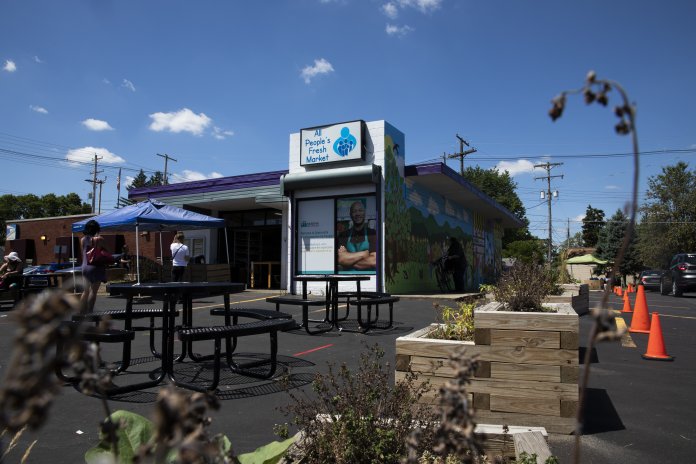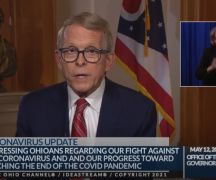It can be hard for those of us who are comfortable to see.
But a top Ohio food bank official issued a stark warning Wednesday: Hundreds of thousands of Ohioans already face food insecurity and if Congress doesn’t act soon, the pain might become impossible for the rest of Ohioans to ignore.
“I don’t think that by and large people realize that there is a very thin line between community and chaos,” said Lisa Hamler-Fugitt, executive director of the Ohio Association of Food Banks. “When you can’t feed yourself and you can’t feed your family and there’s no help or hope available, people are going to do what they have to.”
She said that even before the coronavirus pandemic, 1 in 3 Ohioans were in circumstances such as having low-wage jobs that forced them to choose between which essential goods, such as food or medicine, and essential services, such as rent or utilities, to pay for.
Amid the pandemic, Ohio unemployment nearly tripled — to 631,000 in June — from where it was a year earlier. Now 40% of the people visiting Ohio food banks are new to the system, Hamler-Fugitt said.
According to the U.S. Census’ Household Pulse Survey for the week of July 9-14, nearly 1 million Ohio adults sometimes or often did not have enough to eat in the past week. In addition, more than 400,000 hadn’t paid the previous month’s rent and 360,000 homeowners hadn’t made the previous month’s mortgage payment.
Then, at the end of July, the situation became still worse.
“We’re all feeling the pressure right now because of the loss of the $600-a-week pandemic unemployment assistance,” Hamler-Fugitt said. “That’s been a lifeline for a lot of people who thought they were temporarily laid off and a lot of temporary furloughs and layoffs have now been turned permanent.”
In a presentation earlier this week Hamler-Fugitt gave several examples of spiking demand at food banks:
- On Aug. 11, the Shared Harvest Food Bank and Butler County health agencies held what was intended to be a “mini food distribution” to serve about 200 families. They served 648 families and turned away about 90 more.
- The Greater Cleveland Foodbank’s distribution in the municipal parking lot had been serving more than 1,700 households a week. The week of Aug. 6, that number jumped to more than 2,300, 29% of them newcomers.
- The Second Harvest Foodbank of Clark, Champaign and Logan Counties has seen a 19% increase in demand since Aug. 1.
For now, Hamler-Fugitt said, food supplies are adequate.
Most Ohio food banks have a few weeks worth on hand. But Ohio food banks are asking for an additional $45 million from the $1.3 billion in remaining federal coronavirus relief funds it says the state has on hand to keep from running out of food as some nearly did earlier in the pandemic.
“The supply chain’s really fragile right now,” Hamler-Fugitt said. “That’s why we need to get orders in early.”
People to work at food banks have been in short supply, with many non-profits ordering employees to work from home and erstwhile volunteers staying away out of health concerns.
So far, the Ohio National Guard has filled the void.
“The only reason we’re still operating, that we’re able to handle the demand we have right now, is the governor extended the National Guard — although it’s going to be on a reduced deployment as the guard members cycle back out to return to their civilian jobs. I can’t imagine what our lives would be like if we didn’t have the guard still deployed.”
To volunteer, call the Ohio Association of Food Banks at 614-221-4336 and leave your name, phone number and the county where you want to volunteer or visit www.ohiofoodbanks.org.
It’s vital to have food supplies and the means to distribute them. But Hamler-Fugitt said it’s just as important for the federal government to extend unemployment and other coronavirus relief to a group whose size and misery might surprise many middle and upper-class Ohioans.
“I think there’s been a huge disconnect,” she said. “We’re isolated economically and geographically from those who are constantly in need. Low-income workers — those who are at the grocery stores and taking care of our kids at daycare and our parents in nursing homes — they don’t live in communities of middle income people. And if they do, they try to blend in.”
Congress went on break last week amid a stalemate over coronavirus relief. The Democratically-controlled H0use in May passed a $3 trillion bill that would have extended the $600-a-week unemployment supplement.
In late July as the earlier benefit was about to expire, Senate Majority Leader Mitch McConnell introduced a $1 trillion bill that would have cut the benefit by two thirds, but he admitted that he probably didn’t have the votes to pass it.
Ohio has applied for a $300-a-week supplement that President Donald Trump is trying to provide through executive action, but critics question its legality, workability and its duration.
In Ohio’s Senate delegation, Sherrod Brown, a Democrat, supports the House bill.
Emmalee Kalmbach, spokeswoman for Repulican Sen. Rob Portman, on Wednesday said the senator “has made it clear that he supports another COVID-19 response package. In fact, Portman went to the Senate floor on multiple occasions to detail his priorities for the next COVID-19 response package and voice his support for extending the $600 enhanced federal unemployment benefits as negotiations continue on the next package.”
Hamler-Fugitt said those negotiations can’t happen fast enough.
“We need Congress to act,” she said. “That’s the biggest thing we’re dealing with right now. The thought that they went on vacation is just not acceptable.”
She predicted that if Congress doesn’t act quickly, many of us will no longer be able to ignore the pain in our midst.
“It’s going to be pretty ugly,” she said. “You need to understand, when folks get unemployment benefits, those are spent immediately. They pay rent, mortgage, utility bills, put gas in your car. I envision that we’re going to see homeless families standing on street corners with plastic bags begging, begging, for money.”
***
Also from Ohio Capital Journal:
School funding bill to get new look under new speaker
A school funding bill originally sponsored by new Ohio House Speaker Bob Cupp is getting a fresh look and hopefully time in front of legislative committees before year’s end.
The other original sponsor of the bill, Rep. John Patterson, said a substitute bill is in the works that should touch on longstanding concerns the Ohio Supreme Court had about the constitutionality of the state’s education system.
“We’re taking a more balanced approach in the new bill,” Patterson, D-Jefferson, said.
The state’s contribution to education budgets has stagnated over time, while private schools have benefitted from the EdChoice scholarship program, in which some state funding for public school districts has been redirected to religious, charter and community schools. READ MORE
Coronavirus slows statewide, gains footing in rural Ohio
July’s coronavirus barrage has waned in August, as measured via seven-day moving average of new cases.
However, COVID-19 is now more prevalent in Ohio’s rural counties when adjusted for population than in urban pockets carrying the heaviest caseloads.
According to Ohio Department of Health data, Mercer, Champaign and Lawrence counties are reporting the most cases per 100,000 residents. READ MORE





